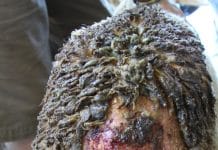Citrus fruit is one of the few fruits of which all parts can be processed. The flesh can be juiced, canned or frozen. The skin can be dried or sugared or used for the production of oils. The white membranes are used for pectin production. In the case of oranges, the juice can also be fermented to produce orange wine.
Grapefruit products
Canned grapefruit: Grapefruit is canned in segments or wedges in sugar syrup of various strengths or artificially sweetened liquor. The canned merchandise is a convenience product used to replace the fresh product. It has a long shelf life and thus extends the availability of the seasonal fresh product. It is used as a breakfast food or a bakery product.
Grapefruit juice: Grapefruit juice was originally produced as a by-product from the drippings of grapefruit sections intended for canning. Today it is a popular breakfast beverage and serves to acidulate other beverages. The bitterness and astringency of grapefruit juice can be made more palatable by sweetening and blending it with other fruit juices. The single-strength juice is preserved by pasteurisation, canning or refrigerated storage, but has a relatively short shelf life, unless preserved by sulphite.

Lemon products
Cold-pressed lemon oil: Cold-pressed lemon oil has an extensive range of applications. The main demand for the oil is as flavouring in the food and beverage industry, but it is also used in cosmetics, pharmaceuticals and household products.
Dried lemon peel: Dried lemon peel is usually a by-product of juice extraction or other processes and finds application in cereals, baked products, sauces, marmalade, spice mixtures and herbal tea.
Lemon juice: Lemon juice is a popular acidulate for other fruit juices, beverages and various food products. It is rich in vitamin C and can be used to substitute salt in food. Although it is seldomly consumed as a beverage on its own, it can be made more palatable by sweetening and the blending of various other juices or ingredients.
Lemon juice concentrate: Concentration and freezing are the best long-term preservation options for lemon juice. The concentrate thus serves as a semi-processed product that can be further processed into various beverages such as lemonade and juice blends, or purely an acidulate.
Lemon purée: Lemon purée is prepared from sound, whole fruits that have been sliced/crushed and puréed. It is a semi-processed product that is useful in the commercial preparation of baked foods, beverages and frozen desserts. It is preserved by freezing. The yield of purée is approximately 50 to 60% of the whole fruit.

Orange products
Cold-pressed orange oil: Orange oil can be obtained from the peel of the orange by piercing or pressing the peel. Cold-pressing is the primary method of extraction and can be performed as a separate operation or as part of the commercial juice-extraction process.
Dried orange peel: Dried orange peel is usually a by-product from juice extraction or other processes. The peel is preserved by drying and finds application in cereals, marmalades, spice mixtures, baked products, sauces and herbal teas.

Frozen orange pulp: Orange pulp is a by-product of the juice extraction plant and mainly consists of the cells removed during the finishing/sieving process. Although nearly all citrus waste can be successfully converted into animal feed or fodder products, orange pulp is mainly used to improve the flavour and mouthfeel of orange juice concentrate upon dilution. The product is preserved by pasteurisation and freezing. Concentration of the pulp is optional.
Orange purée: Orange purée is prepared from sound, whole fruits that have been sliced/crushed and puréed. It is a semi-processed product that is useful in the commercial preparation of baked foods, beverages and frozen desserts. It is preserved by freezing. The yield of purée is approximately 50 to 60% of the whole fruit.
Orange wine (fermented beverage): Orange wine is an alcoholic beverage that is produced by the process of orange juice fermentation, in much the same way as grape juice is fermented to produce wine. The juice from Valencia oranges is used in the making of orange wine. The final product is sweet, with an alcohol content of 14,5% and is served as an aperitif or dessert wine.
Further processing options
The products discussed above are only a small sample of the many processing methods and products available to the citrus processor. Other options range from products such as grapefruit juice concentrate to lemon essence and frozen orange purée. – ARC’s Institute for Agricultural Engineering
The Manual on the Agro-processing of Citrus Fruit contains complete information on the products discussed above, as well as on various processing methods and products available to the farmer. It can be obtained from the Agricultural Research Council’s Institute for Agricultural Engineering. For more information, contact Elmarie Stoltz on 012 842 4017 or send an email to stoltze@arc.agric.za.







